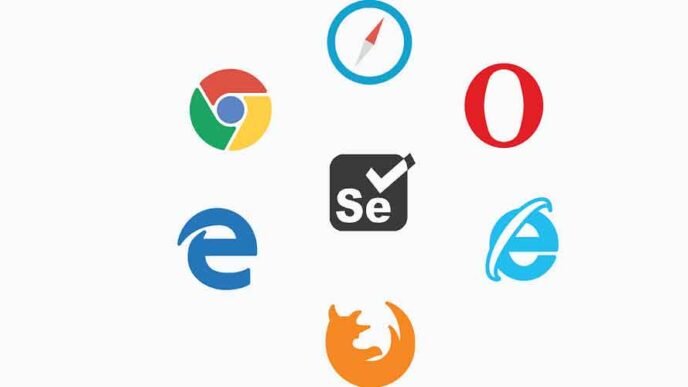The ongoing advancements in digital technology are leading to an increase in the complexity of web applications. This creates additional difficulties for quality assurance engineers, who must extensively test new features across several platforms.
With dependable and well-established open-source tools like Selenium, quality assurance engineers may expedite thorough testing and minimize manual efforts. Nonetheless, it’s crucial to understand best practices if you want to get the best possible results from Selenium testing.
What is Selenium?
- Selenium stands as a widely adopted open-source testing tool designed for web application testing. Its functionality allows testers to craft automated tests across various programming languages to validate web application functionalities. These Selenium tests possess the flexibility to run seamlessly on a multitude of browsers and operating systems.
- How does Selenium work?
- Selenium WebDriver operates by emulating user actions. Testers specify desired user actions within Selenium tests, and the tool seamlessly executes these actions within the browser environment.
- For example, when validating login functionality, a Selenium test script is crafted to input the username and password into respective fields and initiate login. Selenium executes these actions within the browser, subsequently reporting any encountered errors.
- Benefits of Using Selenium
- Framework Integration:Compatible with frameworks like Maven, TestNG, and Jenkins, easing compilation, testing, and continuous integration.
- Cross-Device Testing:Supports testing on multiple devices, including iPhones, Android phones, and Blackberries.
- Community Support: Community-driven support ensures regular updates and extensive resources for troubleshooting and development.
- Ease of Implementation:User-friendly and open-source, it allows for personalized scripting and extension development.
- Add-ons and Reusability: Supports browser compatibility testing and can run multiple scenarios, extending the scope of testing.
- Mouse and Keyboard Simulation:Mimics real user interactions, handling complex events like drag-and-drop and multiple item selection.
- Leveraging Code:Enables testers to utilize the development code, speeding up test cycles and ensuring thorough verification.
Best Practices for Selenium Testing
Let’s have a look at some of the best practices for Selenium Testing.
Employing Wait Commands:
Address synchronization issues inherent in web testing by judiciously employing wait commands. These commands ensure that the test case pauses until the anticipated element appears or the page completes loading before proceeding to the subsequent command. Selenium furnishes various wait commands such as Implicit Wait, Explicit Wait, and Fluent Wait to mitigate such challenges.
Utilizing Assertions:
In Selenium, leverage assertions to verify the presence, enablement, or expected textual/attributive values of elements. By employing assertions, you ascertain that the application operates as anticipated and remains vigilant to any unforeseen alterations.
Harness Parallel Testing with Selenium
A key factor contributing to Selenium’s widespread adoption is its capability for parallel testing. Nearly all prominent test frameworks, including PyTest, PyUnit, TestNG, Cucumber, among others, offer provisions for concurrently executing tests on a Selenium Grid.
Parallel testing with Selenium enables simultaneous execution of identical tests across various environments, encompassing diverse combinations of browsers, platforms, and device emulators. It is highly recommended to incorporate parallel testing into Selenium implementations, as it substantially reduces test execution time.
Developers and testers can leverage cloud-based Selenium Grid solutions like LambdaTest. LambdaTest is an AI-driven test orchestration and execution platform facilitating scalable manual and automation testing across over 3000 real devices, browsers, and OS combinations. Supporting all major test frameworks, LambdaTest’s Grid enhances the performance of parallel tests by executing them on a highly scalable and dependable Selenium Grid infrastructure.
Implementing Test Data Management:
Test data management constitutes a critical facet of test automation, encompassing the creation and administration of test data utilized in your test cases. Ensure comprehensive coverage of all potential scenarios and edge cases within your test data while maintaining a clear demarcation between test data and test code. Employ external data sources like Excel, CSV, or databases to effectively manage test data.
Adopting Version Control:
Version control is indispensable in software development, extending to test automation endeavors. It facilitates effective management of test code alterations, issue tracking, and collaboration among team members. Utilize version control systems like Git, SVN, or analogous tools to streamline the management of your test codebase.
Enhance Web Page Visibility by Maximizing Browser Window:
Among the initial tasks in Selenium test automation is capturing a screenshot of the web page. These screenshots serve developers in debugging and allow stakeholders to monitor product development progress. They also aid in pinpointing whether test failures stem from application issues or problems within the automation script.
By default, Selenium doesn’t open browser windows in maximized mode, potentially impacting the accuracy of these screenshots in test reports. Maximizing the browser window right after loading the test URL ensures comprehensive capture of the entire web page, aligning with best practices regardless of the browser used for Selenium automation. If you’re interested in delving deeper, we have a comprehensive guide on utilizing Selenium WebDriver for capturing full-page screenshots.
Prioritize Web Locator Selection for Robust Automation Tests:
A challenge in Selenium test automation lies in the necessity to adapt automation tests when locator implementations change. ID, Name, Link text, XPath, CSS Selector, and DOM Locator are commonly employed web locators in Selenium WebDriver.
Given the array of options, choosing the appropriate locator is vital to minimize the impact of UI changes on tests. While Link Text is preferable for dynamic scenarios, ID, Class, and Name offer ease of use and greater resilience compared to other locators.
XPath might become necessary in certain situations, but its efficacy varies across browsers, with browsers like Internet Explorer lacking a native XPath engine. In such cases, using a JavaScript XPath Query Engine becomes imperative, albeit slower than native implementations. However, XPath can be brittle, particularly susceptible to failure upon page element reordering or introduction of new elements. For internationalized applications, partial href proves useful for consistent link targeting amid language changes.
For optimal results, adhere to the following web selector hierarchy: id > Name > CSSSelector > XPath. Engage with discussions on performance aspects of popular Selenium locators for further insights.
Formulate a Comprehensive Browser Compatibility Matrix:
Cross-browser testing presents challenges due to the multitude of browser + OS combinations. Formalizing a Browser Compatibility Matrix aids in prioritizing combinations for testing, streamlining efforts and ensuring comprehensive coverage of relevant browsers. This matrix, drawn from product analytics, geolocation data, and audience usage patterns, minimizes development and testing efforts while ensuring thorough validation across browsers pertinent to your product.
Leverage Design Patterns like the Page Object Model (POM) for Scalable Automation:
Maintaining and scaling Selenium test automation scripts necessitates minimizing script modifications in response to UI changes. The Page Object Model (POM) addresses this challenge by centralizing web element controls into separate page classes, reducing code duplication and enhancing test maintenance. By abstracting web elements behind page objects, POM promotes code reusability, simplifies test maintenance, and streamlines the visualization and modeling of tested web pages.
Avoiding Blocking Sleep Calls
It’s well understood that the performance of web applications, or websites, hinges on various external variables like network speed, device capabilities, geographical location, server load, and more. These variables introduce significant unpredictability regarding the time needed to load specific web elements. Consequently, incorporating a delay, or timeout, before executing actions on these elements becomes essential to ensure they load adequately.
However, employing a blocking sleep call (e.g., Thread.sleep in Java, time.sleep in Python) to introduce delay poses certain drawbacks. Such calls halt the test thread for the specified duration, effectively stalling the process in single-threaded applications. While blocking sleep calls serve the purpose of introducing delay, the actual duration of delay remains subject to multiple influencing factors.
Implement Logging and Reporting
When a test within a large test suite fails, identifying the failing test case can be difficult. In such instances, logging becomes invaluable. Properly placed console logs within the test code enhance the understanding of the code and help pinpoint the issue.
Common log levels in programming languages include debug, info, warning, error, and critical. While excessive logging can delay test execution, it is advisable to use error and critical log levels to track the cause of failures effectively.
In addition to logging, reporting is crucial in Selenium test automation. Reports determine the pass/fail status of tests, track the progression of test suites, and provide corresponding test results. Automation test reports improve readability, reduce the time needed for test data maintenance, and simplify feature analysis and test coverage assessment.
Without logging and reporting, the primary purpose of using the Selenium framework is undermined. Hence, these practices are essential for efficient Selenium test automation.
Conclusion
The goals of Selenium automation are to minimize the amount of manual testing required, speed up execution, and find as many errors as possible as soon as possible. But QAs need to adhere to the selenium best practices mentioned above if they want to get the most out of their scripts. Additionally, it will support the creation of a trustworthy test cycle.












